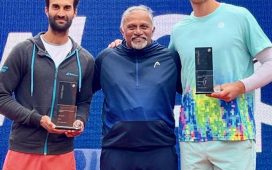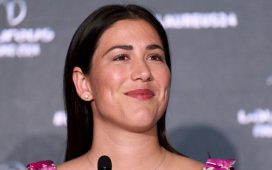With help from $100,000 of a Wimbledon windfall, Dave Miley has been running for president of the International Tennis Federation, meeting and greeting people around the world and watching the bank balance count down.
“It’s like a taxi ride with the meter going: tick, tick, tick,” Miley said in an interview in New York this month. “My account has gone to 80 to 70 to 60 to 40, but it’s O.K. I’m 60 years old. You think I’m going to be worried about this in 20 years’ time? I’m happy to be alive, and you know what? I believe I can win.”
Miley, an Irishman who said he has visited 70 countries during his campaign, will find out if his hunch is correct on Friday, when the I.T.F. votes for president at its annual general meeting in Lisbon.
The incumbent is David Haggerty, an American who has engineered major changes to the I.T.F.’s main team competitions, Davis Cup and Fed Cup, since being elected to a four-year term in September 2015.
The other candidates are Ivo Kaderka, president of the Czech tennis federation, and Anil Khanna of India, who is the head of the Asian tennis federation. Khanna lost by a narrow margin to Haggerty in 2015.
“I think Dave Haggerty will be re-elected, and I am very positive about that,” René Stammbach, an I.T.F. vice president who is also president of Switzerland’s tennis federation, said in an interview last week.
But this has been a particularly fractious period in tennis governance and inside the I.T.F. The organization, based in London, is recognized as the sport’s official governing body by the International Olympic Committee, but it is hardly professional tennis’s only governing body. The men’s tour, the women’s tour and the four Grand Slam tournaments all operate independently and with their own agendas — and often with much more revenue than the I.T.F.
Miley, a political novice who left his longtime post as the I.T.F.’s director of development shortly after Haggerty’s election, has been by far the most outspoken of the challengers.
He has experienced personal tragedy: His wife, Daisy, died suddenly in 2000 of a heart condition, despite Miley’s efforts to revive her. Their three children were 6, 8 and 14.
A former satellite-level player, he has deep tennis connections. His grandfather Jack Miley was Ireland’s first Davis Cup captain, in 1923, and also played at Wimbledon, where Miley now lives and is a member of the All England Club.
“The common theme from the nations I’ve spoken with, especially the more sophisticated ones, is that the I.T.F. is weak compared to the tours and the Slams and the players,” he said.
Miley has criticized Haggerty’s leadership style and major decisions, particularly the significant changes to Davis Cup, the sport’s oldest team competition, and the aborted attempt to create a new transition-tour system for aspiring professional players in 2019. That effort had to be walked back after a player protest.
“A disaster,” Miley said. “They spent over a million dollars and are more or less back to where they started, and nobody is accountable. Nobody was fired.”
The revamped Davis Cup is set to take place in Madrid in November. Since its inception, in 1900, the Davis Cup has been based on a home-and-away system with matches played over best-of-five sets. But as part of a new and potentially lucrative agreement with Kosmos, an investment firm headed by the F.C. Barcelona soccer star Gerard Piqué, the finals of the Cup will now involve 18 teams, including two wild-card teams, playing best-of-three-set matches head to head over a single week.
The change was approved by a two-thirds majority vote at last year’s I.T.F. general meeting. But Miley claims that there is lingering resentment over how that election was handled and over the I.T.F.’s decision to keep the new-look Cup in November rather than moving the event to September.
If it had been moved up two months, the event would have come soon after the United States Open and potentially clashed with the new Laver Cup team event.
The U.S. Open is run by the United States Tennis Association, which is also an investor in the Laver Cup and one of Haggerty’s primary backers. He is a former president of the U.S.T.A.
“Dave told people he would run Davis Cup in September, and that’s why many people voted for the change,” said Miley, who nonetheless intends to honor the Kosmos deal, if elected, and work toward a better format.
Piqué, in a recent interview, confirmed that the long-term plan is to shift the Cup finals to “better” dates. The new-look event has also received a boost with commitments from No. 1 Novak Djokovic of Serbia and No. 2 Rafael Nadal of Spain.
Miley believes change was necessary for Davis Cup, which was losing backing from some top players and sponsors. But he said Haggerty and the I.T.F. board of directors had gone too far too quickly.
Haggerty has argued that there was a unique opportunity to remodel an event in need of remodeling. The Fed Cup, the women’s team event, will get a new format in 2020.
The Fed Cup has traditionally been a financial drain for the I.T.F., but it has announced that the new deal will create an $18 million prize money pool.
New revenue is one of Haggerty’s major arguments for re-election, but Friday’s vote will also be, in some manner, a referendum on the new Davis Cup and Fed Cup before they have been contested.
“Under Haggerty, we tripled the payouts to national federations,” Stammbach said, adding: “Sure, there are one or two issues where you can say he did not do a good job, but take the other eight out of 10 things and he is performing brilliantly with his board.”
Miley believes the I.T.F. can do better over all, and he said he has made his arguments face to face with 80 federation presidents, taking advice from the former British track star Sebastian Coe, who took a similarly peripatetic approach when he ran successfully for the presidency of the I.A.A.F., track and field’s global governing body, in 2015.
Miley, who speaks French and Spanish, hired Vero Communications, the same firm that Coe used in his campaign. Miley deployed $30,000 of the funds that came his way in January when the All England Club, which runs Wimbledon, paid out the equivalent of about $120,000 to each member of the Wimbledon Park Golf Club to complete an early buyout of the club’s lease for Wimbledon’s own expansion.
By then Miley had been contacted by a small group of national federation leaders who thought he would make a good outsider candidate.
“I got my kids together,” Miley said, “and said I was going to run for the presidency, what do you think? And I said, ‘Why not take 20, and we spend it? And I’ll use 100 for the campaign.’ And that’s what I’ve been doing, just blowing through it. I believe in destiny.”








